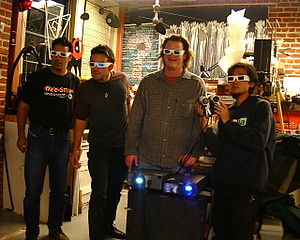Last weekend, we all watched The Hobbit at a 2D movie theater (part of a family get together). The movie was great – but this post is not about the story – but about the technology.
The 2D movie theater used a 2K projection system and the image appeared remarkably soft to us. From our seats, it felt like watching a standard DVD projected on to an HDTV screen and we felt sort of cheated by the theater experience (from a national movie theater chain).
Last night, my wife and I watched The Hobbit in HFR 3D and that was a far better image quality. The theater was using the Sony digital cinema 4k projection system and the RealD 3D system. While half the bandwidth goes to the left eye and half to the right eye, our brains fuse it all back together to give us pretty much a 4k equivalent viewing experience.
Many reviewers have complained that HFR 3D looks too much like TV or a “soap opera” look, but I suspect the complaint is not about HFR, per se, but about the projection system. I saw what they were talking about – there was a slight color cast to the images reminiscent of television, rather than the more saturated colors of film. I have not seen similar complaints about the digital IMAX version, for example.
My guess is this has to do with the HFR 3D projection system itself. The digital projection outputs through (as I understand it) a couple of beam splitters with significantly less light striking the screen. They compensate for this, in part, by using a more reflective silver screen than the usual white screen. I suspect this with perhaps polarized glasses, results in a slight color cast. I especially noticed this early in the movie inside Bilbo’s hobbit home.
One would think theaters would individually do some color calibration. Anyway, the color issue that so many reviewers write about seems likely due to color calibration and not HFR.
The Hobbit has been released in multiple formats including 2D, conventional 24 fps 3D, HFR 3D, IMAX, IMAX 3D (on film) and IMAX HFR 3D.
The IMAX HFR 3D version is available in only a small number of theaters. Just one theater in my entire state is able to show the IMAX HFR 3D.
For most of us that means we can choose between HFR 3D (probably using RealD technology) or IMAX 3D.
“digital” IMAX 3D is sort of, pardon the phrase, a digital “fake” IMAX – unless you have access to one of the very few real IMAX screens.
The screens are much smaller than the original giant IMAX theater screens. Theater chains have reconfigured existing theaters to slightly enlarge the screens from floor to ceiling and wall to wall – but no where near the giant 60 to 90 foot high screens of the original IMAX. The digital IMAX 3D version of The Hobbit is essentially a 24 fps version projected on a slightly larger screen. But, per the IMAX company, digital IMAX has an enhanced projection system – higher contrast, for example – and a better sound system. The technology uses dual 2k projectors operating together – but they are a different aspect ratio than a wide screen 4k projector. (And a 4k image has 4x the image resolution of a 2k image – its doubled in both horizontal and vertical.) “digital IMAX” is impressive technology – the problem is the dilution of the IMAX brand name which was long associated with huge screens and detailed 70mm film resolution into what is sort-of a 4k projection system on smaller screens, albeit with enhanced sound systems and possibly better color and contrast.
Yet, side by side “shoot out” demonstrations of 4k projection systems with digital IMAX practically call them a draw, giving high marks to the digital 4k projections versus the historically better IMAX.
Another wrinkle is calibration of the lensing on the 3D projection systems. A number of viewers on the 3D Photo forum report seeing The Hobbit in 3D theaters where the projection system was not properly aligned, being off by an estimated 1 to 15 pixels. That is enough to cause eye strain.
What this means is that for most of us, the HFR 3D experience will be on par with the “digital” IMAX 3D – unless you are near one of the few “digital IMAX” theaters than can show IMAX HFR 3D.


















